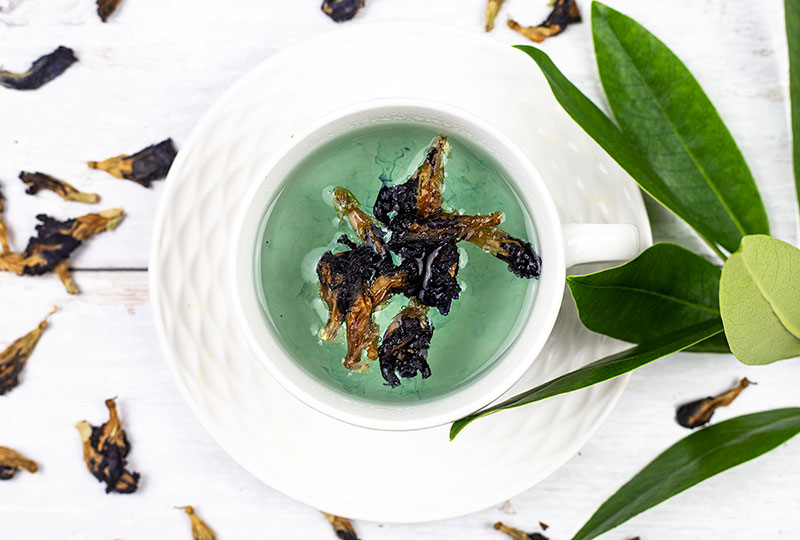Butterfly Pea Flower Tea Recipe & Benefits
This post may contain affiliate links. Simple Loose Leaf is a participant in the Amazon Associates Program, an affiliate advertising program designed to provide a means for sites to earn advertising fees by linking to Amazon.com. In the world of teas, no tea stands out with its beauty more than butterfly flower tea. With the intense, mesmerising deep blue color, and a light refreshing and pleasant flavor, this tea is a must try for anyone interested in herbal infusions. It’s great for daily drinking, for relaxing me-times and afternoon tea parties. Besides, it may provide a whole range of health benefits. Find out what is butterfly pea flower ted how to brew it at home.
What is blue tea?
Blue tea is a herbal tea made from the blue colored flowers of the Clitoria ternatea plant. It’s grown in South East Asian countries, mostly Thailand and Vietnam. Blue tea is also known under the name butterfly flower tea. It’s one of the prettiest teas in the world of herbal teas. Blue tea has an intense blue color, unlike any other tea in the world. Butterfly pea flowers are available in dried or in powdered form. Powders are often used for coloring desserts and smoothies and are sometimes called “blue matcha”. However, blue matcha is not the same as real matcha – a type of green tea powder from Japan. Once steeped in hot water, dried blue pea flowers will start releasing such an intense beautiful blue color that you may think they were artificially colored. Blue and purple color come from anthocyanin[1], an antioxidant found in many blue and purple fruits and vegetables and in Camellia sinensis purple tea. Blue pea flowers are used to make a blue coloring for food and drinks. Interestingly, not only flowers give an intense color. Leaves of the same butterfly pea plant have an intense color too and are used as a green colorant. All parts of the plant are edible[2]. Another unique characteristic of this tea is the ability to change color. Once steeped, tea can change color back and forth, depending on the pH level[3]. If you add a bit of lemon juice and make it more acid, it will turn purple.Is there a difference between butterfly flower tea and butterfly pea flower tea?
No, there is no difference between butterfly flower tea and butterfly pea flower tea. They are both used as a name for the tea made of the same plant. Other names include blue tea, blue pea flower tea, or blue pea tea.What does blue tea smell like?
Blue tea has a unique scent. It’s a bit earthy and woody and somewhat similar to the scent of tempeh, with a deep intense note. Once steeped, the scent changes to a slightly sour and citric, very similar to hibiscus tea.What does blue tea taste like?
Unlike the scent, flavor is very delicate. It’s slightly woody, and slightly sweet, with a light floral note. It’s very refreshing and not intense as you would expect from just smelling it. This tea may appeal to a wider tea drinking population. Blue tea is one of those teas that could be used in many ways to add color to your drinks, without drastically influencing the flavor. When compared to other floral teas, such as rose, jasmine, or lavender, butterfly flower tea has the most delicate flavor which many tea drinkers will probably find pleasant.What level of caffeine does butterfly tea have?
Butterfly tea is a caffeine free herbal tea. Therefore, it’s suitable for daily drinking, for people sensitive to caffeine, elderly and younger people. However, even though it’s caffeine free, avoid it if you are pregnant.How to Make Butterfly Pea Tea
To make a cup of butterfly pea flower tea you will need dried butterfly pea flowers or a powder. Fresh flowers can be used too, but they are rarely available outside South East Asia. Use dried flowers for making herbal infusions, and powder for making lattes or smoothies. Even though the powder is sometimes called blue matcha, it will not give the same frothy drink if prepared with a whisk. Blue tea looks and tastes delicious as iced tea and makes a great drink for outdoor summer tea parties. You can blend it with other ingredients, such as green tea. However, keep in mind that blending with ingredients that have a different pH levels will change the color. Use about 5-7 dried flowers per cup of water. Use fresh spring water for making tea. Bring water to a boil and let it cool down to around 205°F. Preheat your teapot by pouring hot water in and out. Add butterfly pea flowers and steep for about 5 minutes. Do not over-steep. Although they are unlikely to become bitter as green tea, the flavor may still change and become less pleasant. Strain and add sweetener. Alternatively, serve over ice cubes as an iced tea. You can add other ingredients to your cup of tea. Dry adding a few drops of lemon to get an intense purple color. Lime works great with this tea, as it has a more delicate citrusy flavor. Start with a few drops and add more until you get a desired color. You can use almost any teapot for making blue tea. If you don’t have a strainer or a teapot, simply steep the flowers in a cup and scoop out with a spoon.
You can steep dried flowers in a cup. They will start releasing color very fast.
Benefits of Drinking Blue Tea
Blue tea may provide multiple health benefits. It has been used for its medicinal properties for decades. Blue flower tea contains tannins, flavonoids, anthocyanins, peptides and other compounds. It may provide “antioxidant, hypolipidemic, anticancer, anti-inflammatory, analgesic, antipyretic, antidiabetic, CNS, antimicrobial, gastrointestinal, antiparasitic and insecticidal[4]” effects. Furthermore, blue pea flowers is evaluated as both effective and safe[5]. It’s a great drink to enjoy without worrying about potential side effect.1. Antioxidant effect
Studies suggest that blue flower may provide antioxidant activity both when ingested and applied topically. It may provide higher free radical scavenging activity than oregano,[6] and could be used topically in beauty products to provide antioxidant activity and help fight the signs of aging.[7]2. Memory boosting effect
In Ayurveda, Blue flower has been used as a memory and mood boosting plant. Studies suggest it may have a “nootropic, anti-depressant, anti-stress, anxiolytic, and anticonvulsant[8]” effect. It may help enhance cognitive function and bring overall benefits to psychological wellbeing. A study comparing anti-depressant effect of different Ayurvedic plants concluded that blue pea flower may have the highest potential in fighting depression[9].3. Antimicrobial effect
Blue tea may provide antimicrobial and fungicidal activity against many bacteria and fungus. In addition to antimicrobial activity, it may provide an antiparasitic and insecticidal effect too[10].4. Anti diabetic effect
Blue pea flower may be a great drink for people with Type 2 diabetes. Studies suggest it may significantly reduce the blood sugar levels. Both flowers and leaves have the same potential benefits[11].Where to buy pea flower tea?
Butterfly pea tea is available in specialized shops and online. You can buy both organic and non-organic flowers. When buying, pay attention to the color and shape of flowers. Always store any real or herbal tea in an airtight container away from direct sun, humidity, mold or heat. Use within recommended date.Disclaimer: This article is for informational purposes only. It’s not intended to replace medical advice, diagnosis or treatment. Every person is different and may react to different herbs and teas differently. Never use teas or herbs to treat serious medical conditions on your own. Always seek professional medical advice before choosing home remedies.



Leave a comment